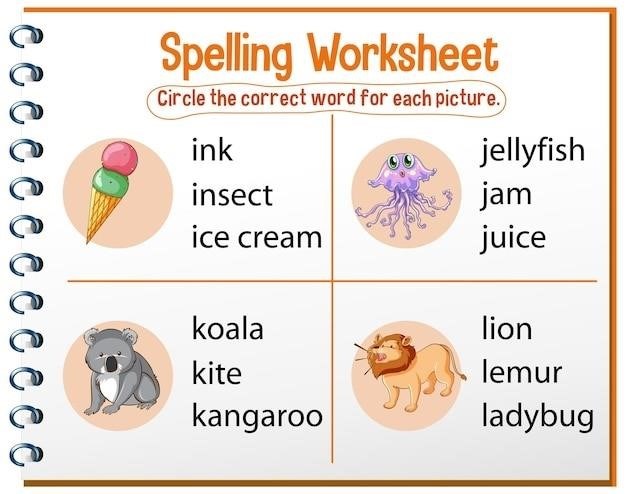phonics rules pdf
Phonics Rules PDFs⁚ A Comprehensive Guide
This guide explores the wealth of phonics rules PDFs available online. Many offer free charts and worksheets, covering vowel and consonant sounds, blends, digraphs, and silent letters. Resources also address advanced topics like multisyllabic words and irregular spellings, providing valuable tools for effective phonics instruction. These PDFs cater to diverse learning needs and offer diverse approaches to decoding and spelling.
Finding Free Phonics Charts and Worksheets
The internet offers a treasure trove of free phonics resources in PDF format. A quick search reveals numerous websites and educational platforms providing downloadable charts and worksheets. These resources often categorize phonics rules by vowel and consonant sounds, including short and long vowels, consonant blends, and digraphs. Many PDFs include colorful illustrations and engaging activities to make learning phonics fun and interactive for young learners. Some offer different levels of difficulty, catering to various age groups and skill levels. Remember to check the source’s credibility to ensure the accuracy and quality of the materials. Look for resources that are aligned with educational standards and offer a clear, structured approach to teaching phonics. Remember to always preview a resource before downloading to ensure it’s the right fit for your needs.
Utilizing Phonics Charts for Effective Learning
Phonics charts, readily available as PDFs, are invaluable tools for effective learning. Their visual nature makes them ideal for reinforcing phonetic relationships. Begin by introducing basic sounds, then gradually introduce more complex concepts like digraphs and blends. Use the charts for interactive activities; have children point to letters and sounds as they read aloud. Incorporate the charts into games and exercises to maintain engagement and aid memorization. For example, create flashcards from the chart or use it as a reference during spelling activities. The laminated charts can also be used as a classroom resource for quick reference throughout the day. Remember to regularly review and reinforce previously learned concepts. The consistent use of phonics charts, coupled with engaging activities, significantly enhances comprehension and retention, making them a cornerstone of effective phonics instruction.
Decoding Vowel and Consonant Sounds⁚ A Detailed Guide
Mastering vowel and consonant sounds is fundamental to reading proficiency. Many phonics PDFs provide detailed guides, breaking down each sound’s pronunciation and various spellings. Start with short vowel sounds (a, e, i, o, u) and their common representations. Then, progress to long vowel sounds, often indicated by silent ‘e’ or vowel teams. Consonant sounds are generally more straightforward, but PDFs can clarify the nuances of consonant blends (e.g., “bl,” “st”) and digraphs (e.g., “sh,” “ch”). These resources often include examples of words illustrating each sound. Practice regularly using these examples, encouraging children to segment words into individual sounds and blend them back together. Interactive exercises within the PDFs can further reinforce understanding. Remember, consistent practice and repetition are key to building a strong foundation in decoding vowel and consonant sounds, thus unlocking the ability to read fluently and confidently.

Common Phonics Rules Explained
This section delves into frequently encountered phonics rules. Explore short and long vowel sounds, consonant blends and digraphs, and the often-confusing impact of silent letters. Numerous PDFs offer clear explanations and ample examples to solidify understanding.
Short and Long Vowel Sounds⁚ Rules and Examples
Mastering short and long vowel sounds is fundamental to reading and spelling in English. Short vowel sounds are typically represented by a single vowel letter, as in “cat,” “bed,” “pig,” “hop,” and “sun.” These sounds are often the most straightforward to learn. Long vowel sounds, however, can be more complex. They are often indicated by a variety of spelling patterns. One common pattern is the vowel-consonant-silent e pattern, as seen in words like “make,” “bike,” “rope,” and “cute.” The silent “e” at the end lengthens the preceding vowel. Other patterns involve vowel digraphs (two vowels together), such as “ea” in “eat,” “oa” in “boat,” “ai” in “rain,” and “ee” in “see.” Diphthongs, which involve a glide from one vowel sound to another, also contribute to vowel complexity. Examples include “oy” in “boy” and “ow” in “cow.” Understanding these various patterns is crucial for decoding words accurately. Many phonics PDFs provide extensive lists of words illustrating short and long vowel sounds, accompanied by clear explanations and practice exercises to reinforce learning. These resources are invaluable for both teachers and students seeking to master these essential phonetic concepts.
Consonant Blends and Digraphs⁚ Mastering Common Combinations
Consonant blends and digraphs represent common phonetic challenges in English, but mastering them significantly improves reading and spelling skills. Consonant blends involve two or more consonants blended together, where each sound is still heard, such as “bl” in “blue,” “st” in “stop,” or “str” in “strong.” These combinations often appear at the beginning or end of words. Digraphs, on the other hand, consist of two consonants that combine to make a single new sound, unlike blends where individual sounds are heard. Common examples include “sh” in “ship,” “ch” in “chair,” “th” in “think” or “this,” and “ph” in “phone.” Some digraphs represent sounds not found in the individual letters’ pronunciations. Phonics PDFs often provide detailed charts illustrating common consonant blends and digraphs, along with word lists to practice their application. These resources typically offer systematic approaches to learning these combinations, often using visual aids and engaging exercises. Understanding these concepts is crucial for decoding unfamiliar words and improves spelling accuracy, ultimately enhancing reading fluency and comprehension. The effective use of such PDFs is vital for a solid grasp of English phonetics.
Silent Letters and Their Impact on Pronunciation
Silent letters, a frequent source of confusion for English language learners, significantly impact pronunciation and spelling. These letters, despite their lack of audible sound, play a crucial role in word etymology and spelling patterns. Understanding silent letters requires recognizing their historical influence and their function within specific word families. For instance, the silent “e” at the end of a word often lengthens the preceding vowel sound (e.g., “make,” “hope”). Similarly, the silent “gh” in words like “night” or “tough” reflects historical pronunciations. Phonics PDFs frequently include sections dedicated to common silent letters, providing examples and explanations of their impact on pronunciation. These resources often categorize silent letters based on their position within a word (beginning, middle, or end) and their effect on adjacent sounds. Mastering silent letter patterns significantly improves reading accuracy and spelling skills. By understanding the rules governing silent letters, learners can better predict pronunciations and spell words correctly, leading to improved fluency and comprehension in English. The use of well-structured phonics PDFs is invaluable in this process.

Advanced Phonics Rules and Patterns
Exploring advanced phonics delves into multisyllabic words, applying rules to spelling, and tackling irregular words and exceptions. Mastering these complexities enhances reading and writing fluency significantly. High-quality phonics PDFs provide structured guidance through these challenges.
Multisyllabic Word Decoding Strategies
Decoding multisyllabic words, those with multiple syllables, presents a significant challenge for young learners but is crucial for reading fluency. Effective strategies involve breaking down words into individual syllables, identifying the vowel sounds within each syllable, and applying phonics rules to each part. This segmented approach helps decipher the pronunciation of each syllable, leading to accurate pronunciation of the entire word. Resources like phonics PDFs often include exercises and activities designed to build this skill. These resources might use visual aids, such as color-coding syllables or using diagrams to illustrate the process. Practical exercises may involve identifying syllable boundaries in words, or matching syllables to their corresponding sounds. Furthermore, understanding syllable types—open, closed, etc;—can significantly aid in decoding. Ultimately, consistent practice using these strategies, reinforced by engaging phonics resources, empowers students to confidently tackle complex words.
Applying Phonics Rules in Spelling
Mastering spelling requires a solid understanding of phonics rules and their application. Phonics instruction emphasizes the connection between sounds and letters, enabling students to translate spoken words into written form. Effective spelling hinges on accurately identifying the individual sounds within a word and then selecting the corresponding letters or letter combinations. Many phonics-based spelling programs utilize activities that focus on this direct sound-to-letter correspondence. These activities frequently involve exercises where students must write words dictated by the teacher or write words based on given sounds. Furthermore, understanding common spelling patterns, such as vowel teams and consonant blends, is essential. Regular practice with these patterns, possibly using flashcards or worksheets found in phonics PDFs, helps solidify these connections in memory. This approach, grounded in systematic phonics instruction, significantly improves spelling accuracy and reduces reliance on rote memorization.
Understanding Irregular Words and Exceptions
While phonics rules provide a framework for decoding and spelling, the English language presents numerous exceptions and irregularities. These words, defying typical phonetic patterns, require specific memorization. A significant portion of commonly used words fall into this category, highlighting the limitations of solely relying on phonetic rules. Resources such as well-designed phonics PDFs often include lists or exercises focusing on these irregular words. Strategies for tackling these exceptions include mnemonic devices, visual aids, and repeated exposure through reading and writing. Understanding that these words exist and require separate learning is crucial for comprehensive literacy development. The challenge lies in balancing the systematic application of phonics with the acknowledgment and accommodation of these exceptions, ensuring a holistic approach to reading and spelling. This approach prevents frustration and encourages a deeper understanding of the complexities of the English language. Accepting the presence of these exceptions allows for a more nuanced and comprehensive approach to literacy.
Resources for Phonics Instruction
High-quality phonics PDFs are readily available online, offering comprehensive guides, interactive exercises, and printable materials. These resources support both educators and students in mastering phonics skills effectively. Many free and paid options exist to suit various needs and learning styles.
Where to Find High-Quality Phonics PDFs
Locating reliable and effective phonics PDFs requires a strategic approach. Educational websites specializing in literacy resources often provide free downloadable phonics charts and worksheets. These websites frequently offer a range of materials catering to different age groups and skill levels, ensuring accessibility for diverse learners. Additionally, online marketplaces and educational publishers offer comprehensive phonics workbooks and curriculum materials in PDF format, often incorporating interactive elements and engaging activities. Remember to check reviews and previews before purchasing paid resources to ensure alignment with your specific needs. Teacher resource sites, often featuring contributions from educators, are another valuable source. These platforms frequently provide free and paid resources, including phonics charts, games, and lesson plans. When searching online, use specific keywords such as “phonics rules PDF,” “phonics worksheets PDF,” or “phonics charts PDF” to refine your search and increase the likelihood of finding relevant and high-quality materials. Carefully review the content to ensure accuracy and alignment with established phonics teaching methodologies. Consider factors such as clarity, organization, and the inclusion of diverse examples to maximize the effectiveness of your chosen resources.


